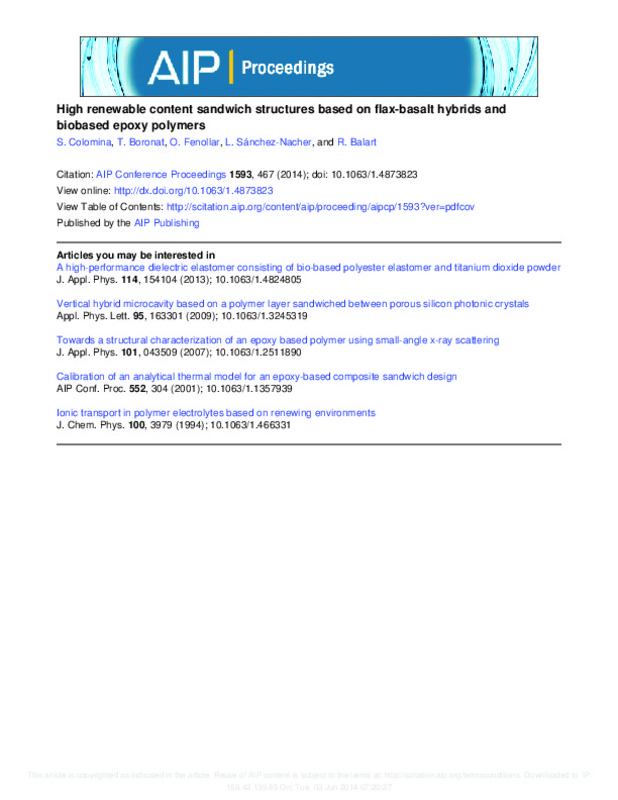JavaScript is disabled for your browser. Some features of this site may not work without it.
Buscar en RiuNet
Listar
Mi cuenta
Estadísticas
Ayuda RiuNet
Admin. UPV
High renewable content sandwich structures based on flax-basalt hybrids and biobased epoxy polymers
Mostrar el registro sencillo del ítem
Ficheros en el ítem
| dc.contributor.author | Colomina, S.
|
es_ES |
| dc.contributor.author | Boronat Vitoria, Teodomiro
|
es_ES |
| dc.contributor.author | Fenollar Gimeno, Octavio Ángel
|
es_ES |
| dc.contributor.author | Sánchez Nacher, Lourdes
|
es_ES |
| dc.contributor.author | Balart Gimeno, Rafael Antonio
|
es_ES |
| dc.date.accessioned | 2015-04-22T10:46:49Z | |
| dc.date.available | 2015-04-22T10:46:49Z | |
| dc.date.issued | 2014 | |
| dc.identifier.issn | 0094-243X | |
| dc.identifier.uri | http://hdl.handle.net/10251/49123 | |
| dc.description.abstract | In the last years, a growing interest in the development of high environmental efficiency materials has been detected and this situation is more accentuated in the field of polymers and polymer composites. In this work, green composite sandwich structures with high renewable content have been developed with core cork materials. The base resin for composites was a biobased epoxy resin derived from epoxidized vegetable oils. Hybrid basalt-flax fabrics have been used as reinforcements for composites and the influence of the stacking sequence has been evaluated in order to optimize the appropriate laminate structure for the sandwich bases. Core cork materials with different thickness have been used to evaluate performance of sandwich structures thus leading to high renewable content composite sandwich structures. Results show that position of basalt fabrics plays a key role in flexural fracture of sandwich structures due to differences in stiffness between flax and basalt fibers | es_ES |
| dc.language | Inglés | es_ES |
| dc.publisher | American Institute of Physics (AIP) | es_ES |
| dc.relation.ispartof | AIP Conference Proceedings | es_ES |
| dc.rights | Reserva de todos los derechos | es_ES |
| dc.subject | Composite | es_ES |
| dc.subject | Epoxidized Vegetable Oil | es_ES |
| dc.subject | Basalt | es_ES |
| dc.subject | Flax | es_ES |
| dc.subject | Cork | es_ES |
| dc.subject | Composite materials | es_ES |
| dc.subject | Reinforced polymers | es_ES |
| dc.subject | Fracture mechanics | es_ES |
| dc.subject | Laminates | es_ES |
| dc.subject | Polymer structure | es_ES |
| dc.subject.classification | INGENIERIA DE LOS PROCESOS DE FABRICACION | es_ES |
| dc.subject.classification | CIENCIA DE LOS MATERIALES E INGENIERIA METALURGICA | es_ES |
| dc.title | High renewable content sandwich structures based on flax-basalt hybrids and biobased epoxy polymers | es_ES |
| dc.type | Artículo | es_ES |
| dc.identifier.doi | 10.1063/1.4873823 | |
| dc.rights.accessRights | Abierto | es_ES |
| dc.contributor.affiliation | Universitat Politècnica de València. Departamento de Ingeniería Mecánica y de Materiales - Departament d'Enginyeria Mecànica i de Materials | es_ES |
| dc.contributor.affiliation | Universitat Politècnica de València. Instituto de Tecnología de Materiales - Institut de Tecnologia de Materials | es_ES |
| dc.description.bibliographicCitation | Colomina, S.; Boronat Vitoria, T.; Fenollar Gimeno, OÁ.; Sánchez Nacher, L.; Balart Gimeno, RA. (2014). High renewable content sandwich structures based on flax-basalt hybrids and biobased epoxy polymers. AIP Conference Proceedings. 1593:467-470. doi:10.1063/1.4873823 | es_ES |
| dc.description.accrualMethod | S | es_ES |
| dc.relation.publisherversion | http://dx.doi.org/10.1063/1.4873823 | es_ES |
| dc.description.upvformatpinicio | 467 | es_ES |
| dc.description.upvformatpfin | 470 | es_ES |
| dc.type.version | info:eu-repo/semantics/publishedVersion | es_ES |
| dc.description.volume | 1593 | es_ES |
| dc.relation.senia | 278365 |








